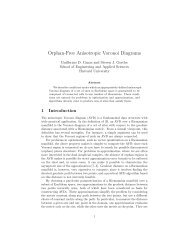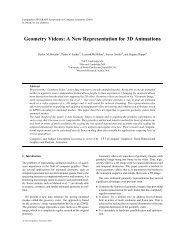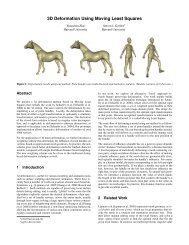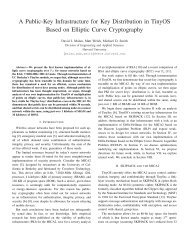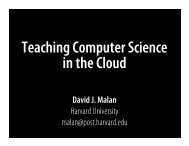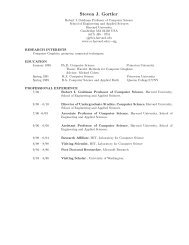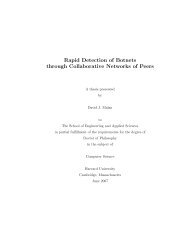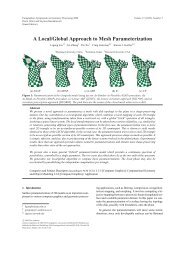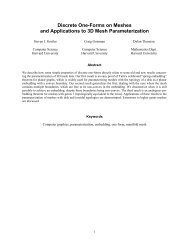CS50 Sandbox - FTP Directory Listing - Harvard University
CS50 Sandbox - FTP Directory Listing - Harvard University
CS50 Sandbox - FTP Directory Listing - Harvard University
Create successful ePaper yourself
Turn your PDF publications into a flip-book with our unique Google optimized e-Paper software.
of sandboxing for students’ code, then, simple enough thatTFs aren’t disinclined to use it.We thus set out to tackle both problems at once. In thesections that follow, we present our solution. <strong>CS50</strong> <strong>Sandbox</strong>is our environment for secure execution of untrusted code.In Section 2, we present the design goals therefor. In Section3, we present <strong>CS50</strong> <strong>Sandbox</strong>’s implementation details,including its front end (an HTTP-based API) and back end(a Linux-based cluster). In Section 4, meanwhile, we introduce<strong>CS50</strong> Run, a web-based code editor built atop <strong>CS50</strong><strong>Sandbox</strong> that enables students to write code in a browserthat’s compiled and executed server-side. In Section 5, weintroduce <strong>CS50</strong> Check, an autograding framework built into<strong>CS50</strong> <strong>Sandbox</strong> that enables students and instructors aliketo assess the correctness of code. In Section 6, we presentfuture work and conclude.2. DESIGN GOALSEven though <strong>CS50</strong> happens to introduce students to C,along with PHP and JavaScript, we wanted our sandboxedenvironment to be language-agnostic so that courses besidesours could leverage the platform. Moreover, we needed itto withstand execution of buggy (if not adversarial) code,lest infinite loops or fork bombs throttle the system. Andwe wanted the environment to accommodate the course’sstyle of homework, fairly complex programs that can oftenbe designed in any number of ways, rather than have to alterthe course’s workload to accommodate technology. And sowe set out with these design goals in mind:• support interactive and non-interactive execution ofprograms written in any language, particularly thosecommonly used in introductory courses (e.g., C, C++,Java, JavaScript, OCaml, Perl, PHP, Python, Ruby,Scheme, et al.);• support build tools like ant and make;• support standard error, input, and output;• limit consumption of CPU cycles, disk space, file descriptors,and RAM;• restrict network access, both inbound and outbound;• prevent reading and writing of unsandboxed files; and• prevent denial-of-service attacks.Before proceeding to implement, we vetted existing solutions.In the web-based space are ideone [14], codepad [15],CodeEval [2], and compilr [3], all of which support browserbasedcompilation and interpretation of code. But only thelast supports interactive execution of programs, though itlacks an API. Even so, we would want more control over ourenvironment than a third party would likely allow. In particular,we would want it to behave identically to our VM,with the same OS, binaries, and libraries installed on both,so that students’ programs behave the same, no matter thecontext.In the autograding space, related works abound [7–9], althoughmany are now dated and don’t support many languages.Most closely related is Web-CAT [1], perhaps thebest known, but Web-CAT doesn’t sandbox code to thedegree that we sought. Nor does it support interactivityor clustering. Unit-testing frameworks also abound for C(and other languages), but none offer the simplicity thatwe wanted for the course’s earliest projects especially. Autolab[5], meanwhile, is the closest incarnation of our ownvision for sandboxing but isn’t yet available as open source.It also spawns entire virtual machines for sandboxing tests,overhead that we wished to avoid.3. IMPLEMENTATION DETAILSAt a high level, <strong>CS50</strong> <strong>Sandbox</strong> is a web-based black boxthat allows for secure execution of untrusted code. Its inputsinclude files (e.g., hello.c), commands (e.g., ./a.out),signals (e.g., SIGINT), and standard input. And its outputsinclude exit codes plus standard output and error.<strong>CS50</strong> <strong>Sandbox</strong> is not meant to be used by humans directly,as via a GUI. Rather, it accepts inputs via HTTPthrough API calls, and it returns outputs via HTTP asJSON objects [4]. Clients (e.g., <strong>CS50</strong> Run, per Section 4)can issue those calls via Ajax (if sandboxing non-interactiveprograms) or via WebSocket [17] (if sandboxing interactiveprograms).<strong>CS50</strong> <strong>Sandbox</strong> is currently packaged for Red Hat-basedsystems (among them CentOS, Fedora, RHEL, and ScientificLinux) but could be ported to Debian-based systems aswell. It is available as open source athttp://cs.harvard.edu/malan/.3.1 Front End<strong>CS50</strong> <strong>Sandbox</strong>’s front end is an HTTP-based API, amongwhose endpoints are /upload and /run.3.1.1 /uploadTo upload one or more files to the environment, a clientneed only POST them to /upload (as multipart/formdata).<strong>CS50</strong> <strong>Sandbox</strong>’s response will be a JSON object withtwo keys: files, whose value is an array of the filenamesPOSTed, and id, whose value is a unique identifier for thecollection of files, per the below.{"files": [String, ...]"id": String}3.1.2 /runTo execute a non-interactive command (e.g., clang hello.c)inside of <strong>CS50</strong> <strong>Sandbox</strong>, a client need only POST to /runa JSON object with two keys: cmd, whose value is the commandline to execute, and sandbox, whose value is a JSONobject with one key, homedir, whose value is the uniqueidentifier for a previously uploaded collection of files, perthe below.{"cmd": String,"sandbox": { homedir: String }}<strong>CS50</strong> <strong>Sandbox</strong> will then copy those files into a temporary$HOME, in which cmd will be executed. Upon successful execution,the server will respond with a JSON object of theform
{"code": Number,"sandbox": String,"script": String,"stderr": String,"stdout": String}where code is the command’s exit code, sandbox is a uniqueidentifier for the temporary $HOME so that the client mayexecute subsequent commands (e.g., ./a.out) in the samesandboxed environment, script is the command’s terminaloutput (with standard error and standard output interwoven),stderr is the command’s standard error, and stdoutis the command’s standard outputTo execute an interactive command that expects standardinput (e.g., ./a.out) inside of <strong>CS50</strong> <strong>Sandbox</strong>, a client caninstead establish (or emulate, as with socket.io [12]) a Web-Socket with <strong>CS50</strong> <strong>Sandbox</strong> and emit a run event, whose payloadis also a JSON object whose keys are, as before, cmdand sandbox. <strong>CS50</strong> <strong>Sandbox</strong> will then execute cmd, emittingstdout and stderr events over the socket as standardoutput and error, respectively, are generated. <strong>CS50</strong> <strong>Sandbox</strong>will also emit a stdin event when it detects that cmd isblocking for input so that the client knows to provide. Oncecmd exits, <strong>CS50</strong> <strong>Sandbox</strong> will emit an exit event, whose payloadis an exit code plus standard output and error, alongwith a unique identifier for the $HOME used. A client can alsointerrupt cmd prematurely by emitting a SIGINT event.3.2 Back EndUnderneath the hood, <strong>CS50</strong> <strong>Sandbox</strong> is an HTTP serverwritten in JavaScript for Node.js [11], an open-source runtimebuilt atop V8 [6] whose event-driven architecture iswell-suited for handling asynchronous events (e.g., interactivestandard I/O). Moreover, Node.js supports non-blockingI/O, which means that execution of one (slow-running) cmdwon’t block that of another. The architecture supports clustering,whereby <strong>CS50</strong> <strong>Sandbox</strong> can be run on any numberof load-balanced servers.Upon receiving an HTTP request whose endpoint is /upload,<strong>CS50</strong> <strong>Sandbox</strong> saves each file POSTed asynchronously todisk in a directory whose name serves as the unique identifierfor that collection of files, which is then returned to theclient.Upon receiving an HTTP request whose endpoint is /runor a run event over a socket, <strong>CS50</strong> <strong>Sandbox</strong> sets up a “sandbox,”a temporary $HOME in which a cmd will be executed.It copies a collection of files (identified by an id) into thatsandbox, creates a new user (whose username is also id andwhose password is locked), and then assigns $HOME to thatuser. It then executes cmd on behalf of that user, via sudo.But it first wraps cmd with a call to nice, so as to prioritizeits execution below the HTTP server itself. It also wrapscmd with a call to seunshare, which further confines cmd tothe temporary $HOME (and its own /tmp) within an alternate“context,” a feature of SELinux [10] that restricts processes’behavior, blocking access to /etc/passwd, /proc, and more.Finally, cmd is wrapped further with a call to strace, whichallows <strong>CS50</strong> <strong>Sandbox</strong> to detect writes on standard outputand error (as well as reads on standard input).So that cmd can only consume its fair share of resources,<strong>CS50</strong> <strong>Sandbox</strong> imposes constraints using pam_limits, whichcaps processes’ consumption of CPU cycles, disk space, filedescriptors, RAM, and more on a per-user basis, ergo thecreation of a user per sandbox. Meanwhile, iptables restrictsnetwork access. <strong>CS50</strong> <strong>Sandbox</strong>’s own HTTP serveradditionally monitors wall time, killing long-running processes(in addition to fork bombs).Once cmd exits, <strong>CS50</strong> <strong>Sandbox</strong> responds to the client andtears down the sandbox after waiting a few minutes for anysubsequent cmd.We happen to run <strong>CS50</strong> <strong>Sandbox</strong> on Amazon EC2, usingAmazon ELB for load-balancing and Amazon S3 for sharedstorage, but the environment can just as easily be run locallyon one or more servers, using DNS or layer-3 alternativesfor load-balancing and NFS or SMB for shared storage asneeded. Indeed, the environment can be installed with asingle command (yum).4. <strong>CS50</strong> Run<strong>CS50</strong> Run is a web-based code editor that lives athttps://run.cs50.net/. Built atop <strong>CS50</strong> <strong>Sandbox</strong>, <strong>CS50</strong>Run enables students to write, within a browser, code inany language, execution of which happens server-side. Implementedin JavaScript, HTML, and CSS, <strong>CS50</strong> Run leverages<strong>CS50</strong> <strong>Sandbox</strong>’s API to create an illusion that executionis local, even providing students with a terminal window inwhich they can not only see standard output and error butprovide standard input as well. Via a drop-down can studentsselect the language in which they wish to write code,each of which maps to a particular cmd (e.g., clang for C).Each cmd is executed automatically for students, based onthat drop-down’s selection, but each cmd is displayed in theillusory terminal window so that students can see exactlywhat’s happening under the hood. Lines of code, meanwhile,are automatically numbered and syntax-highlighted.And via a button can students save revisions of their code,so that they can roll back in time and recover from crashes.Figure 1 depicts.Not only does <strong>CS50</strong> Run enable students to work on smallprograms in lectures and sections without booting a VM,it also empowers students to check their code’s correctnessinstantly via integration with <strong>CS50</strong> Check.5. <strong>CS50</strong> Check<strong>CS50</strong> Check is an autograding framework built into <strong>CS50</strong><strong>Sandbox</strong> that enables black- and white-box testing of students’code. Like <strong>CS50</strong> <strong>Sandbox</strong> itself, its front end is anHTTP-based API. Its back end, meanwhile, comprises seriesof checks (i.e., tests) that are written in JavaScript (but cancheck the correctness of programs written in any compiledor interpreted language).5.1 Front EndTo run some program (i.e., cmd) through a series of checks,a client (e.g., <strong>CS50</strong> Run, which itself uses <strong>CS50</strong> Check toprovide students with browser-based feedback) need onlyPOST the program’s file(s) to <strong>CS50</strong> <strong>Sandbox</strong> via /upload,at which point it can then contact /check, <strong>CS50</strong> Check’ssole endpoint, to initiate testing.5.1.1 /checkTo run a series of (instructor-defined) checks against a previouslyuploaded collection files, a client need only POST to/check a JSON object of the following form, where checks
Figure 1: This is <strong>CS50</strong> Run, a web-based code editor built atop <strong>CS50</strong> <strong>Sandbox</strong> that enables students to writeprograms in any language within a browser.is a unique identifier for the series of checks, and sandboxdefines (as it also does for /run) a sandbox to use for thechecks’ execution, where homedir is the unique identifier fora previously uploaded directory of files, a copy of which willbe mounted as $HOME for each of the checks in the series.{"checks": String,"sandbox": { homedir: String }}Upon execution of checks, the server will return a JSONobject of the form{"results": Object}where results is an object, each of whose keys is the uniqueidentifier for a check in the series, the value of which is anobject of the form{"dependencies": [String, ...],"description": String,"result": Boolean,"script": [Object, ...]}where dependencies is an array, each of whose elements isthe unique identifier for another check on which the checkdepends, description is a human-friendly description of thecheck, result is either• true, which signifies that the check passed,• null, which signifies that the check was not executedbecause of a failed or erred dependency, or• false, which signifies that the check failed,and script is an array of objects, each of the form{"actual": { type: String, value: String },"expected": { type: String, value: String }}where expected describes what was expected, and actualdescribes what actually occurred, if anything, up until thepoint when the check passed or failed. For instance, thisresponse indicates that two checks (compiles and runs)passed:{"results": {"compiles": {"dependencies": [],"description": "Does hello.c compile?","result": true,"script": [Object, ...]},"runs": {"dependencies": ["compiles"],"description": "Does a.out run?","result": true,"script": [Object, ...]}}}By contrast, this response indicates that one check passedwhereas another check failed (because of an unexpected exitcode):
{"results": {"compiles": {"dependencies": [],"description": "Does hello.c compile?","result": true,"script": [Object, ...]},"runs": {"dependencies": ["compiles"],"description": "Does a.out exit with 0?","result": false,"script": [...,{"actual": {"type": "exit","value": 1},"expected": {"type": "exit","value": 0}}]}}}Similarly does this response indicate that one check passedwhereas another check failed (because of unexpected standardoutput):{"results": {"compiles": {"dependencies": [],"description": "Does hello.c compile?","result": true},"runs": {"dependencies": ["compiles"],"description": "Does a.out print \"hello, world\"?","result": false,"script": [...,{"actual": {"type": "stdout","value": "goodbye, world"},"expected": {"type": "stdout","value": "hello, world"}}]}}}And this response indicates that two checks failed, one ofwhich wasn’t even executed because of its dependency onthe other:{"results": {"compiles": {"dependencies": [],"description": "Does hello.c compile?","result": false,"script": [...,{"actual": {"type": "exit","value": 1},"expected": {"type": "exit","value": 0}}]},"runs": {"dependencies": ["compiles"],"description": "Does a.out run?","result": null,"script": []}}}5.1.2 Back EndOn the back end, series of checks are implemented inJavaScript as Node.js “modules,” objects whose keys arechecks’ names, whose values are anonymous functions thatreturn functional tests. Checks themselves are implementedas “chains,” sequences of asynchronous methods, each ofwhose execution is delayed until its preceding sibling invokesa callback. These chains hide from instructors the underlyingimplementation details of asynchronous code, which isnot always easy to write. After all, the objective of <strong>CS50</strong>Check is to challenge students to pass checks, not instructorsto write them! Below is a representative series of twochecks, the first of which checks, by running clang (with.run, which runs a cmd in a sandbox), whether hello.ccompiles with an exit code of 0, the second of which checkswhether the resulting a.out says hello, as per the RegExp(which could alternatively be a String specifying a file ondisk against which to compare standard output).
module.exports = {"compiles": function(check) {return check("Does hello.c compile?").run("clang hello.c").exit(0);},"runs": ["compiles", function(check) {return check("Does a.out print \"hello, world\"?").run("./a.out").stdout(/^hello, world$/).exit(0);}};<strong>CS50</strong> Check includes support for other “links” in checks’chains as well, including .diff (which compares two files fordifferences), .exists (which checks whether a file exists),.stderr (which checks students’ standard error against aRegExp or file), and stdin (which checks whether a programis blocking for standard input).<strong>CS50</strong> Check also supports specification of dependencies.Indeed, in the above, the value of runs is actually an array,the first of whose values is "compiles", which prescribesthat the second check should be executed only if the first ofthe two passes.6. FUTURE WORK, CONCLUSION<strong>CS50</strong> <strong>Sandbox</strong> is an environment for secure execution ofuntrusted code that we designed underneath both <strong>CS50</strong> Run,a web-based code editor that enables students to write codein any compiled or interpreted language, and <strong>CS50</strong> Check,an autograding framework that enables students and instructorsalike to assess the correctness of code.In Fall 2012, we will deploy <strong>CS50</strong> <strong>Sandbox</strong> not only toour own undergraduates but to as many as 120,000 edX studentsas well. Coupled with <strong>CS50</strong> Run and <strong>CS50</strong> Check,<strong>CS50</strong> <strong>Sandbox</strong> will ultimately enable students to work onproblems within browsers during lectures and sections, withoutthe need for client-side VMs. Moreover, it will enableus to embed alongside curricular materials real-time codingexercises on which students will receive instant feedback.So that the infrastructure scales dynamically with load,we may eventually utilize Amazon Auto Scaling, which willallow us to define thresholds for load, beyond which additionalservers will be spawned automatically. We anticipateadversarial attacks on the system, and so we plan to hardenthe system over time as we detect weaknesses. In particular,we expect to write our own SELinux policy with which toconfine each cmd all the more. We plan, too, to augment<strong>CS50</strong> Check’s pool of methods to support measurement ofresources consumed during runtime (e.g., CPU cycles andRAM).Meanwhile, we expect that the thousands of submissionsthat <strong>CS50</strong> <strong>Sandbox</strong> will collect over time will yield insightsinto the process by which students write code and respondto continual feedback.8. REFERENCES[1] Anuj R. Shah. Web-CAT: A Web-based Center forAutomated Testing. Master’s thesis, VirginiaPolytechnic Institute and State <strong>University</strong>, 2003.[2] CodeEval Inc. CodeEval. http://www.codeeval.com/.[3] Compilr Inc. compilr. https://compilr.com/.[4] D. Crockford. The application/json Media Type forJavaScript Object Notation (JSON).http://www.ietf.org/rfc/rfc4627.txt?number=4627.[5] Dave O’Hallaron et al. Autolab.http://autolab.cs.cmu.edu/.[6] Google Inc. V8 JavaScript Engine.http://code.google.com/p/v8/.[7] J. A. Harris, E. S. Adams, and N. L. Harris. Makingprogram grading easier: but not totally automatic. J.Comput. Sci. Coll., 20(1):248–261, Oct. 2004.[8] D. Jackson. A semi-automated approach to onlineassessment. In Proceedings of the 5th annualSIGCSE/SIGCUE ITiCSE conference on Innovationand technology in computer science education, ITiCSE’00, pages 164–167, New York, NY, USA, 2000. ACM.[9] D. Jackson and M. Usher. Grading student programsusing assyst. In Proceedings of the twenty-eighthSIGCSE technical symposium on Computer scienceeducation, SIGCSE ’97, pages 335–339, New York,NY, USA, 1997. ACM.[10] James Morris. SELinux Project Wiki.http://selinuxproject.org/.[11] Joyent, Inc. Node.js. http://nodejs.org/.[12] LearnBoost, Inc. Socket.IO. http://socket.io/.[13] Scott Graham. Skulpt. http://www.skulpt.org/.[14] Sphere Research Labs. ideone. http://ideone.com/.[15] Steven Hazel. codepad. http://codepad.org/.[16] Syntensity. Python on the Web.http://syntensity.com/static/python.html.[17] World Wide Web Consortium. The WebSocket API.http://dev.w3.org/html5/websockets/.7. ACKNOWLEDGMENTSMany thanks to Dan Walsh of RedHat and to Glenn Holloway,Joseph Ong, Mike Tucker, Nate Hardison, Rob Bowden,and Tommy MacWilliam of <strong>Harvard</strong> for their assistancewith this work.



